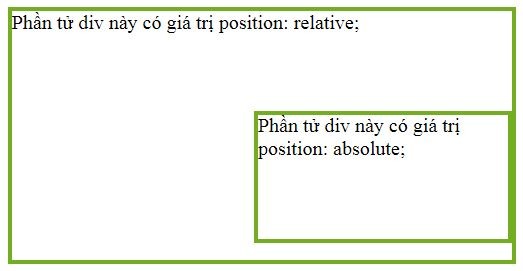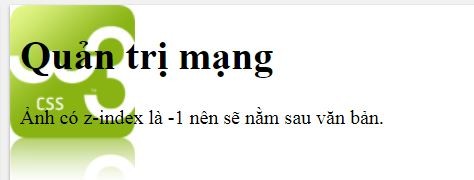Location of element in CSS
The position feature determines the positioning method for an element (static - static, relative - relative, fixed - fixed, absolute - absolute or sticky - fixed).
CSS position properties
The position property is used to determine the method of positioning the element with 5 values:
- static
- relative
- fixed
- absolute
- sticky
The element is placed on the position with the top, bottom, left and right properties.However, they only work when you have set the previous position property.Depending on the value of location selection, they also operate differently.
position: static;
The default HTML element is located statically, unaffected by the top, bottom, left, and right properties.
The element has position: static;cannot be located in any other way but always follow the normal flow of the page.
div.static {
position : static ;
border : 3px solid #73AD21 ;
}
position: relative;
The element with this value places the position relative to the normal position.Set the top, bottom, left and right positions for the element with this property to adjust its position relative to the normal position.Other content cannot be adjusted to fit the space left behind.
div.relative {
position : relative ;
left : 30px ;
border : 3px solid #73AD21 ;
}
position: fixed;
The position: fixed element is positioned relative to the viewport, which is always in one place even when scrolling.The top, bottom, left, and right positions must be used to determine.
The fixed element leaves no space on the page where it usually lies:
div.fixed {
position : fixed ;
bottom : 0 ;
right : 0 ;
width : 300px ;
border : 3px solid #73AD21 ;
}
position: absolute;
The element using position: absolute is positioned relative to any other positioned parent element, except static (instead of viewport like position: fixed).
However, if there is no parent element, it will use the body text and move along when scrolling the page.
div.relative {
position : relative ;
width : 400px ;
height : 200px ;
border : 3px solid #73AD21 ;
}
div.absolute {
position : absolute ;
top : 80px ;
right : 0 ;
width : 200px ;
height : 100px ;
border : 3px solid #73AD21 ;
}

The position: absolute value must always have a parent element
position: sticky
The sticky value element is placed based on the position when the user scrolls the page.The sticky element changes between relative and fixed, depending on the scroll position.It will be relative until the position to the viewport's point, then it will "stick" there (like position: fixec).
Note: Internet Explorer, Edge 15 and earlier versions do not support position: sticky.Safari requires a prefix -webkit- and must specify at least 1 in the top, bottom, left, and right positions.
The example below the sticky element is at the top of the page (top: 0) when the roll position is reached.
div.sticky {
position : -webkit-sticky ; /* Safari */
position : sticky ;
top : 0 ;
background-color : green ;
border : 2px solid #4CAF50 ;
}
The element overlaps
When positioning the element, they can overlap.The z-index property defines the order for the elements (which first, which after) and the value can be negative or positive.
img {
position : absolute ;
left : 0px ;
top : 0px ;
z-index : -1 ;
}
The element with a larger order value will be first.If z-index is not specified, any element behind the HTML code will be displayed first.

Set the display order for elements
Previous lesson: Maximum element width in CSS
Next article: Overflow in CSS
You should read it
- Ways to move image position in Word
- How to Change the Position of the Taskbar in Windows 7
- The term of familiar locations in PUBG
- How to move photos, change the image position in Word
- Resize, position, rotate, and flip images in Adobe Illustrator
- How to change the position of New Tab button on Chrome
- How to change the position of the Taskbar on Windows 11
- The safest seat when traveling by car, train, plane
May be interested
- How to view and delete your location history on Facebook
 if you enable the location history feature on the facebook application, it will periodically enter your exact location in the location history, even if you are not using the application. fortunately, you can delete the entire location history or delete specific cases and turn off this feature completely.
if you enable the location history feature on the facebook application, it will periodically enter your exact location in the location history, even if you are not using the application. fortunately, you can delete the entire location history or delete specific cases and turn off this feature completely. - Outline in CSS
 outline is a line around the element, located outside the border to highlight the element.
outline is a line around the element, located outside the border to highlight the element. - Some apps will still know your real location even if you use a VPN
 one benefit of using a virtual private network (vpn) is that it masks your real location. but if that's your main goal, you might be surprised to learn that some apps can still see your real location.
one benefit of using a virtual private network (vpn) is that it masks your real location. but if that's your main goal, you might be surprised to learn that some apps can still see your real location. - Open Inspect Element and View Source on Microsoft Edge browser
 if you are a developer, you may have to use the site's source code. and you may also have to use the inspect element tool to find a specific code and design of a website. if you are using the microsoft edge browser, the view source and inspect element options are disabled by default.
if you are a developer, you may have to use the site's source code. and you may also have to use the inspect element tool to find a specific code and design of a website. if you are using the microsoft edge browser, the view source and inspect element options are disabled by default. - How to Share a Location on Apple Messages
 to share a location on apple messages, open messages → tap on a conversation → tap the i icon → tap 'send my current location.' note: location services must be enabled prior to sending or sharing your location. tap the...
to share a location on apple messages, open messages → tap on a conversation → tap the i icon → tap 'send my current location.' note: location services must be enabled prior to sending or sharing your location. tap the... - Instructions for using Snapchat without sharing the location
 snapchat is one of the best social networking services that has been popular in recent years. this application has many interesting and fully functional features that a social network needs. however, it has a drawback that not all users want it to be location sharing. follow the article below to be comfortable using snapchat without sharing your location.
snapchat is one of the best social networking services that has been popular in recent years. this application has many interesting and fully functional features that a social network needs. however, it has a drawback that not all users want it to be location sharing. follow the article below to be comfortable using snapchat without sharing your location. - How to view someone's location on Snapchat
 in 2017, snapchat introduced a new feature called 'snap map', allowing you to see everyone's location on snapchat.
in 2017, snapchat introduced a new feature called 'snap map', allowing you to see everyone's location on snapchat. - How to send live location on Instagram
 you can now send your location directly on instagram, or any location to your friends when needed. this makes it easier for us to exchange locations right on instagram.
you can now send your location directly on instagram, or any location to your friends when needed. this makes it easier for us to exchange locations right on instagram. - How to fake GPS on the phone
 fake gps on the phone allows you to create fake locations anywhere in the world, ie the real location on the phone will be hidden and replaced by a new location of your choice.
fake gps on the phone allows you to create fake locations anywhere in the world, ie the real location on the phone will be hidden and replaced by a new location of your choice. - whoo - a location sharing app - Location sharing app
 whoo - a location sharing app is a social networking app developed by linq,inc. and is available for download on the apple app store and google play store.
whoo - a location sharing app is a social networking app developed by linq,inc. and is available for download on the apple app store and google play store.










 Overflow in CSS
Overflow in CSS How to create checkboxes with CSS Grid
How to create checkboxes with CSS Grid 9 reasons you should equip a little knowledge of HTML and CSS
9 reasons you should equip a little knowledge of HTML and CSS Top 5 popular CSS Framework that you should keep in mind
Top 5 popular CSS Framework that you should keep in mind Master CSS Flexbox in just 5 minutes
Master CSS Flexbox in just 5 minutes Introduction to CSS
Introduction to CSS